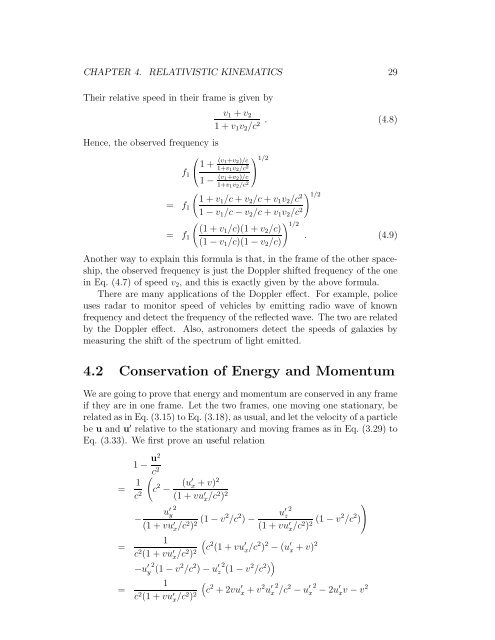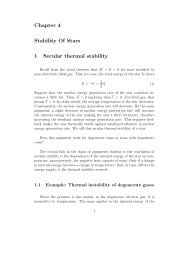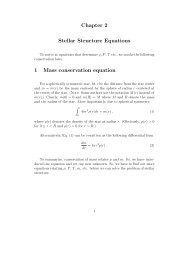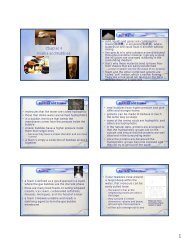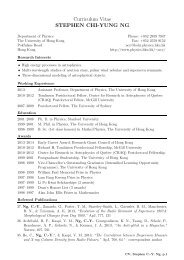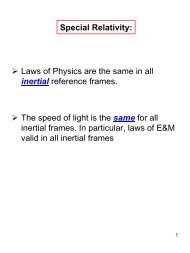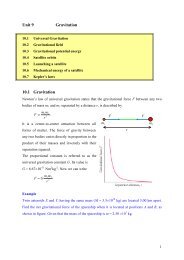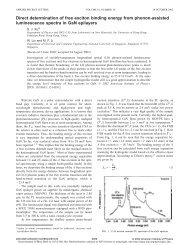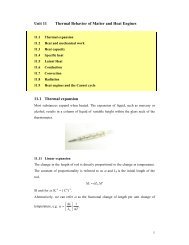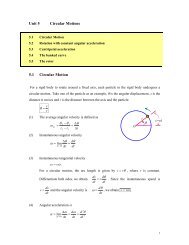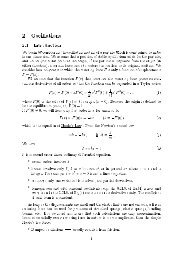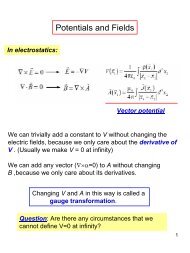here - Department of Physics, HKU
here - Department of Physics, HKU
here - Department of Physics, HKU
Create successful ePaper yourself
Turn your PDF publications into a flip-book with our unique Google optimized e-Paper software.
CHAPTER 4. RELATIVISTIC KINEMATICS 29<br />
Their relative speed in their frame is given by<br />
Hence, the observed frequency is<br />
v 1 + v 2<br />
1 + v 1 v 2 /c 2 . (4.8)<br />
⎛<br />
f 1<br />
⎝ 1 + (v ⎞<br />
1+v 2 )/c 1/2<br />
1+v 1 v 2 /c 2<br />
⎠<br />
1 − (v 1+v 2 )/c<br />
1+v 1 v 2 /c 2<br />
= f 1<br />
( 1 + v1 /c + v 2 /c + v 1 v 2 /c 2<br />
1 − v 1 /c − v 2 /c + v 1 v 2 /c 2 ) 1/2<br />
= f 1<br />
( (1 + v1 /c)(1 + v 2 /c)<br />
(1 − v 1 /c)(1 − v 2 /c)<br />
) 1/2<br />
. (4.9)<br />
Another way to explain this formula is that, in the frame <strong>of</strong> the other spaceship,<br />
the observed frequency is just the Doppler shifted frequency <strong>of</strong> the one<br />
in Eq. (4.7) <strong>of</strong> speed v 2 , and this is exactly given by the above formula.<br />
T<strong>here</strong> are many applications <strong>of</strong> the Doppler effect. For example, police<br />
uses radar to monitor speed <strong>of</strong> vehicles by emitting radio wave <strong>of</strong> known<br />
frequency and detect the frequency <strong>of</strong> the reflected wave. The two are related<br />
by the Doppler effect. Also, astronomers detect the speeds <strong>of</strong> galaxies by<br />
measuring the shift <strong>of</strong> the spectrum <strong>of</strong> light emitted.<br />
4.2 Conservation <strong>of</strong> Energy and Momentum<br />
We are going to prove that energy and momentum are conserved in any frame<br />
if they are in one frame. Let the two frames, one moving one stationary, be<br />
related as in Eq. (3.15) to Eq. (3.18), as usual, and let the velocity <strong>of</strong> a particle<br />
be u and u ′ relative to the stationary and moving frames as in Eq. (3.29) to<br />
Eq. (3.33). We first prove an useful relation<br />
1 − u2<br />
= 1 c 2 ( c2<br />
=<br />
=<br />
c 2 − (u′ x + v)2<br />
(1 + vu ′ x /c2 ) 2<br />
u ′ 2<br />
y<br />
u ′ 2<br />
z<br />
−<br />
(1 + vu ′ x /c2 ) (1 − 2 v2 /c 2 ) −<br />
(1 + vu ′ x /c2 ) (1 − 2 v2 /c 2 ) ⎠<br />
1 (<br />
c 2 (1 + vu ′<br />
c 2 (1 + vu ′ x/c 2 ) 2 x /c2 ) 2 − (u ′ x + v)2<br />
−u ′ y2 (1 − v 2 /c 2 ) − u ′ 2 z (1 − v 2 /c 2 ) )<br />
1 (<br />
c 2 + 2vu ′<br />
c 2 (1 + vu ′ x /c2 ) 2 x + v2 u ′ 2 x /c 2 − u ′ x2 − 2u ′ x v − v2<br />
⎞


